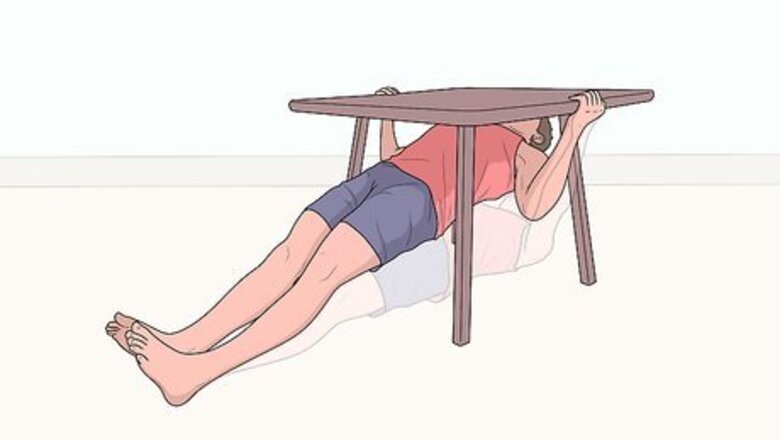
views
Performing Alternative Bodyweight Exercises
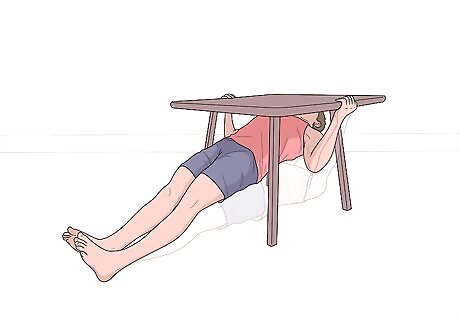
Do inverted rows underneath a sturdy table for a close pull-up alternative. Lay down on the floor underneath a sturdy table with your legs out straight under the table and your shoulders directly below the edge of the table. Reach your arms up and grab the edge, pull your body straight up as far as you can go while keeping your heels on the ground, then lower yourself back down to do 1 rep. This exercise is also sometimes known as an Australian pull because you get “down under” a ledge to perform it. If you can get outside, you can also do this exercise underneath something like a railing or a bench in a park or somewhere around your neighborhood.
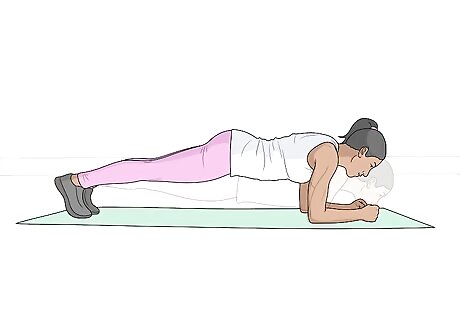
Try doing elbow push-ups to work your lats, shoulders, and core. Get down into a push-up position with your biceps directly underneath your shoulders but with your forearms and elbows flat on the floor. Push yourself up using your forearms and elbows, so your arms are straight out in front of you at about a 45-degree angle. Lower yourself back down to finish 1 rep. Make sure to keep your core tight and your body in a straight line while you perform this move. Don’t let your back curve or bend in any way.
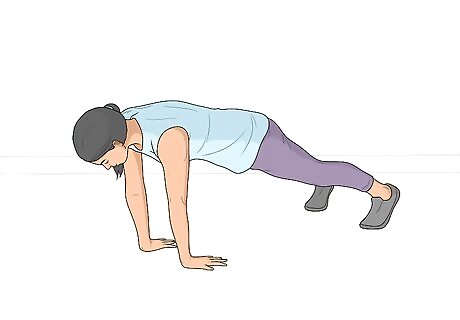
Do bicep planks to work your biceps and core. Get into a regular high plank position with your toes on the ground, your body straight, and your arms straight below your shoulders with your palms on the ground. Turn your hands so that your fingertips face backwards and the heels of your hands face forwards. Hold the position for as long as you can, then take a 30-60 second rest and repeat the move. Like a regular plank, this works your core, but it places more emphasis on your arms and biceps, which are muscles that a pull-up uses.
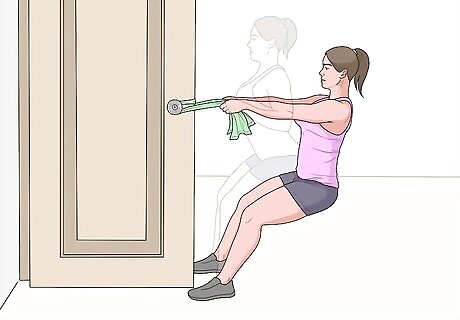
Use a towel and a door to do standing towel rows that hit pull-up muscles. Loop a towel around the door knob or handle of a sturdy door, so that the middle of the towel rests against the inside edge of the door. Grab the ends of the towel and pull them straight towards your torso while facing the edge of the door. Bend at your knees and sit back into your hips like you’re about to sit down in a chair, then pull your body towards the door. Sit back into the starting position to do 1 rep. You can also do this same move by wrapping a towel around a sturdy pole or pillar somewhere in your home and rowing yourself towards it. Use a longer towel for more range of motion, which will make the move harder.
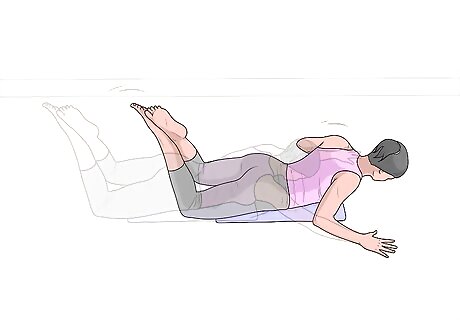
Do floor pulls using a towel if you have a smooth floor. Lay a towel out flat on the floor and lie down with your chest on the towel and your arms straight out in front of you with the palms flat against the floor. Press your palms into the floor and pull yourself forward along the floor until your hands are beside your head, then slide back to the starting position for 1 rep. This is basically a lying-down version of the pull-up that uses your own bodyweight and the floor instead of a bar to target the same muscles. The towel allows you to slide easily across the smooth floor. Imagine a bar straight between your hands on the floor and pretend you’re doing a pull-up on that bar. When you get your chin up to the “bar,” you lower yourself back down again.
Using Weights to Work Similar Muscles
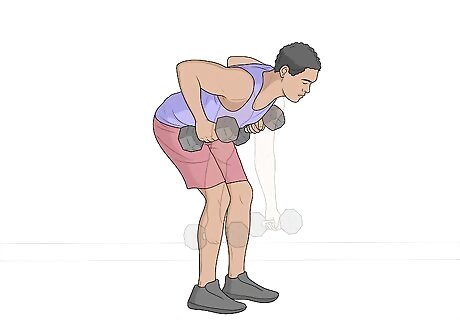
Do bent-over dumbbell or barbell rows to work your back and grip muscles. Stand straight and hold a pair of dumbbells or a barbell in front of your thighs with the tops of your hands facing forward. Bend your knees slightly and lean forward at about a 45-degree angle. Pull the dumbbells or barbell straight up to your chest, then lower the weight back down again to complete 1 repetition. If it’s your first time doing bent-over rows, start out with a light weight and focus on your form, so you don’t hurt your back. Once you are comfortable with the form, move up to a higher weight. This is a great way to work your back’s lat muscles, which are 1 of the primary muscles that pull-ups work, as well as your trapezoids, biceps, and other supporting muscles. Adding size and strength to your lats and the surrounding muscles can give you a toned, V-shaped back.
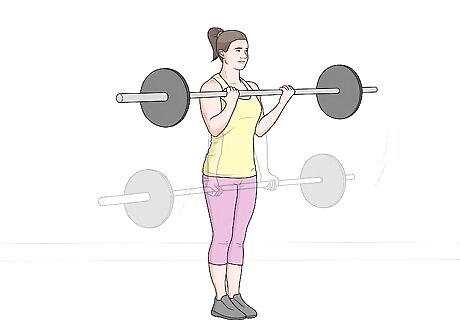
Do dumbbell or barbell curls to work your biceps. Stand straight and hold a pair of dumbbells or a barbell down in front of your thighs with an underhand grip and your fingers facing up. Curl the dumbbells or barbell up to your chest and shoulders, then lower the weight back down to the starting position to do 1 rep. If you have dumbbells, you can try some variations. For example, alternate curling them on 1 side at a time to focus on the muscles in 1 arm per repetition. Or, you can hold them with your thumbs facing forward in what’s called a hammer grip to engage different stabilizer muscles. Try doing seated dumbbell curls by sitting down on a chair or bench. Hold the dumbbells down at your sides with an underhand grip or a hammer grip, then curl them up at the same time or alternate between arms. This puts even more emphasis on the biceps than standing.
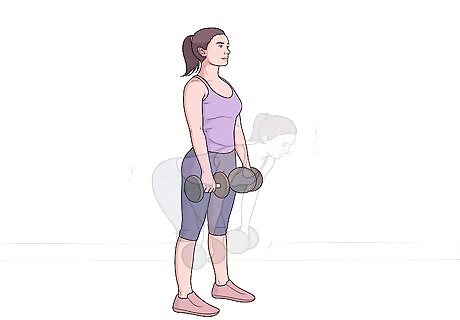
Try Romanian deadlifts with a barbell or dumbbells for a full-body lift. Hold a pair of dumbbells or a barbell in front of your thighs while standing up straight with your feet about shoulder width apart. Bend your knees slightly and hinge forward at the waist simultaneously until your back is parallel to the floor. Straighten up back to the starting position to finish 1 repetition. Romanian deadlifts are a variation on traditional deadlifts that are easier to do at home because you don’t need mats or an Olympic-size barbell. This exercise can replace pull-ups by targeting your back’s lat muscles, trapezoids, rhomboids, biceps, core, and many other upper body muscles. It also works your hamstrings, glutes, and quads, which makes it one of the best all-around lifts you can do.
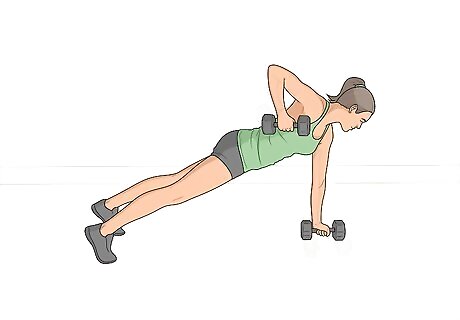
Perform renegade rows with dumbbells to work your lats, biceps, and core. Grab a pair of dumbbells and get down into a pushup or plank position with the dumbbells on the floor directly below your shoulders and your thumbs facing forward. Pull the dumbbell on 1 side straight up to your shoulder while keeping your body in the plank position and the other dumbbell on the floor. Lower the dumbbell back down to perform 1 repetition, then repeat this on the other side. It’s best to use hexagon-shaped dumbbells for this exercise because they can sit flat on the floor. It’s hard to balance and stay still to perform this lift if you only have round dumbbells. Take this to the next level by doing 1 pushup between each renegade row repetition. You’ll get a great upper body workout that targets many of the same muscles as a pull-up and more. Make sure you do the same number of repetitions on each side to get even muscle growth.
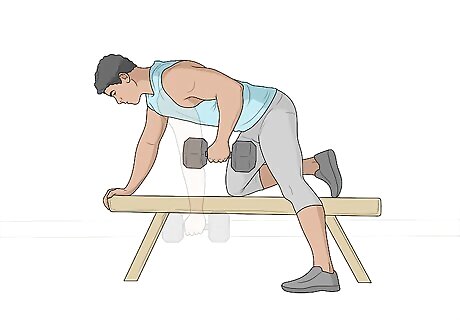
Work your lats and supporting muscles with one-arm dumbbell rows. Place 1 knee and 1 hand, on the same side of your body, on a bench or a similar flat, raised surface and bend forward so that your back is parallel with the surface. Grab a dumbbell in your other hand and let it hang straight down at your side. Pull the dumbbell straight up to the side of your chest, keeping your elbow in close to your torso, then lower it down to finish 1 rep. Do a set of 3-15 reps, then switch sides and do the same number of reps. This is a great pull-up replacement because you can use heavy weights to really hit your lats hard like a pull-up. One-arm dumbbell rows can grow your lats a lot and even help you increase the number of pull-ups you can do the next time you have access to a pull-up bar.
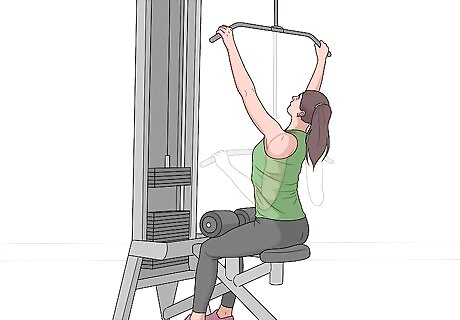
Mimic pull-ups with cable pull-downs if you have a home cable machine. Attach a lat pull-down bar to the cable machine and sit down facing the machine. Grab the pull-down bar with your arms straight above your head, then pull it down in front of your face to your chest. Raise it back up over your head slowly to do 1 rep. Try different grip variations to target different muscles more or less. For example, a wide grip will target your back muscles like your lats more, whereas a narrow grip will target your biceps and arms more.
Doing Exercise Band Workouts
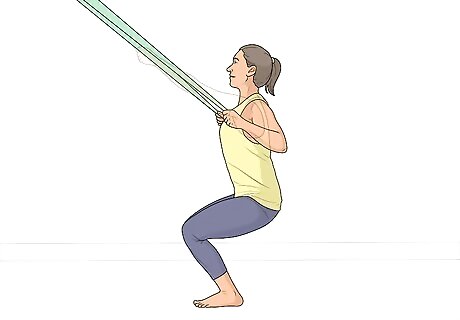
Perform resistance band pull downs for a basic pull-up replacement. Grab a resistance band with your hands shoulder-width apart, then raise up over your head so your palms are facing forward. Pull the band down in front of your chest, so your shoulders squeeze together behind your back and your palms end up at about shoulder height. Raise the band back up to complete 1 repetition. You can do this exercise standing up or kneeling down. Kneeling down will work your core’s stabilizer muscles more.
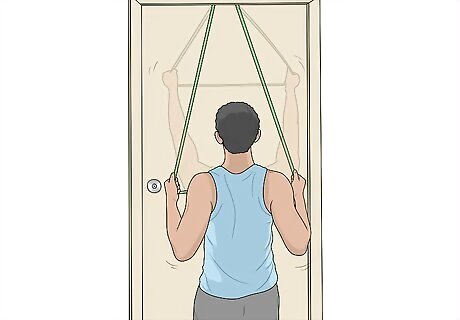
Try door resistance band pull downs to closely replicate a pull-up. Loop your resistance band over the top edge of a sturdy door, stand in front of the inside edge of the door, and grab both sides of the band with your palms facing forward and your arms above your head. Pull the 2 sides of the resistance band straight down until your hands are beside your chest, then raise your arms back up for 1 rep. Don’t lean back when you do this type of exercise band pull down. You can place your forehead against the inside edge of the door to help you stand up straight. You could also loop your resistance band over a sturdy exposed beam or pipe as an alternative to a door. Alternate pulling down 1 arm at a time for a variation of this exercise.
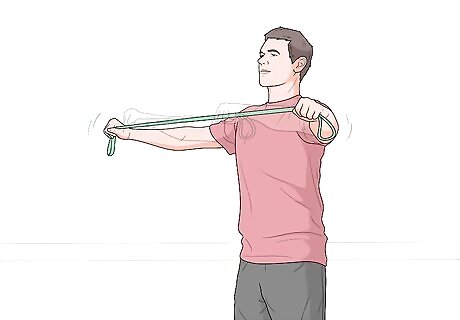
Practice doing resistance band T holds to engage your core and back. Grab a resistance band and hold it at shoulder height with your palms facing in front of you. Stretch the band out while pinching back your shoulders until your arms are almost straight out at your sides and your palms are facing in opposite directions. Hold it for at least 20 seconds, then release it and repeat the exercise. Keep your neck relaxed and focus on using your core, shoulder blades, and upper back muscles to hold the resistance band stretched out.


















Comments
0 comment